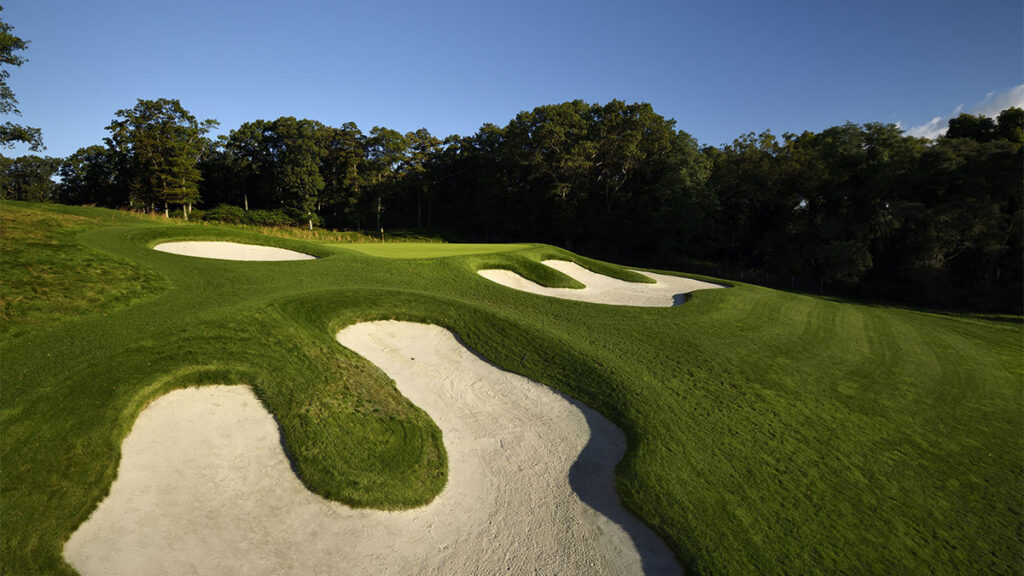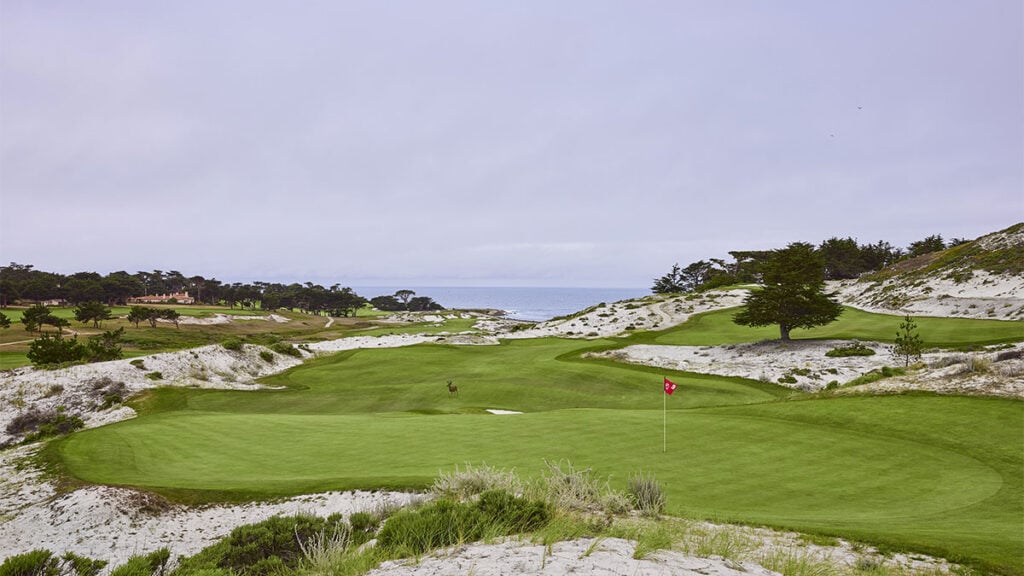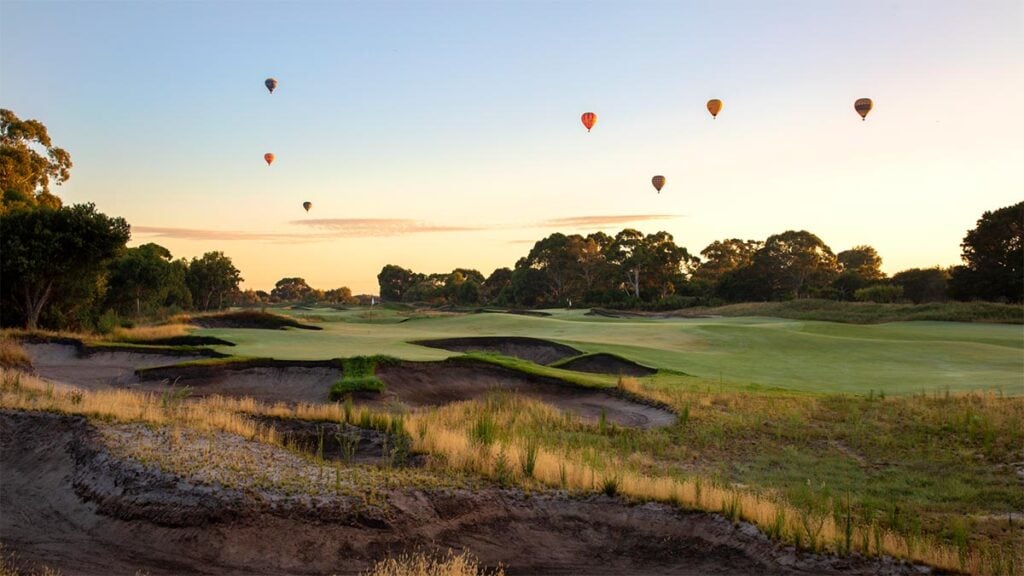Assessing Bethpage Black and Cypress Point ahead of matchplay tournaments, the Ryder and Walker Cups.
It’s easy to make golf courses play hard. Almost any course – even your own – can present a tournament-worthy test for great players if you stretch the tee markers as far back as they can go, grow the rough long, tuck the pins and dry out the greens.
Of course, a setup like that is directed at defending par, effective for strokeplay championships where the winner is determined by the lowest total score. Matchplay events – where holes are won and lost and the overall score of a player isn’t relevant – beckon a more nuanced kind of design. Matchplay is most compelling not when players are grinding out pars but when they’re pushed to their mental and emotional limits by unique hole setups and the strains of the match. Even shorter courses can provide exciting golf when the pressure is on to match your opponent’s birdie. Ideally, the architecture must be capable of stressing skill, strategy and composure in equal measure.
This year’s Ryder Cup venue, the Black course at Bethpage State Park in New York (September 26-28), is a proven championship strokeplay design that has battered fields during the 2002 and 2009 US Opens (won by Tiger Woods and Lucas Glover, respectively) and the 2019 PGA Championship (Brooks Koepka). It can be obviously brutal, but does it also possess the architectural intangibles that can enhance the theatrics of the world’s most anticipated matchplay contest? This year’s Walker Cup (September 6-7) is hosted by Cypress Point for the first time since 1981. Generally considered too short for professional tournaments (Cypress Point last hosted the AT&T Pebble Beach Pro-Am in 1990), it will rely on wind and tempting hole setups to flummox today’s long-hitting amateurs.
Whether for a Ryder Cup or Walker Cup or any other elite-level competition, you need five design and setup elements to make a great matchplay course. With these in mind, let’s examine how Bethpage and Cypress Point will measure up.
LENGTH
Prodigious yardage isn’t always necessary to produce entertaining and competitive matches, but a certain amount of length is needed at the elite level if driving the ball well is to be as determinative in winning and losing as the other aspects of the game. As matchplay is often about match-ups (in singles and in teams), identifying players who can take advantage of lengthy par 5s and monster par 4s is a critical factor in pairings.
Bethpage rates highly in this regard demanding length and precision with three par 4s measuring longer than 500 yards (not counting the 484-yard 15th, the hardest hole in each of the three previous majors) and fairways that dogleg and pinch in landing zones. In fact, the Black combines the difficult driving aspects of the two previous European host clubs on which the US team struggled: Le Golf National in France, where the narrow fairways demanded pure accuracy, and Marco Simone in Italy, which presented opportunities for power players to cut corners and aggressively shape big carries.
Cypress Point, on the other hand, is vulnerable to power. The course is listed at 6,620 yards for the Walker Cup and in normal conditions, the amateurs will be able to push drives well down the fairways to set up wedges and pitch shots into most par 4s. The brilliance of Cypress Point, ranked No.3 for more than a decade on America’s 100 Greatest Courses, was never predicated on it being long. Players work to score by navigating the tilting fairways through the maze of Alister MacKenzie’s bunkers and with precise approaches into small, heavily sloped greens. Some competitors might be tempted to bomb away, but more birdies will come not because of driver distance but rather savvy, risk-taking and crafty short games.

ADJUSTABILITY
The ability to keep players off balance hole to hole and day to day is essential to great matchplay courses. Length adjustment through tee-marker placement introduces a range of landing zones, putting added emphasis on adaptation and decision-making. Part of the head-to-head calculus is selecting the correct club based on the standing of the match and what the opponent has just done – the wider the range of targets, the tougher the choices.
Adjustable setups also factor heavily in foursomes, where teammates alternate shots. Setups that irregularly alternate between very long and shorter holes require strategic forethought into pairings and the order of who hits the tee shots. If courses can mix these combinations up daily, the pairings
become a puzzle.
Even though par values don’t matter in matchplay, the psychology of a hole changes when a routine par 5 is set up as a formidable par 4. Most courses that host major matchplay events already have at least one par 4 that’s reachable from the tee, but an adjustable setup can throw a twist at the competitors if a usually long two-shot hole is presented as driveable.
The par-4 eighth and ninth holes at Cypress will be fascinating to watch. Both are reachable from the tee but require high-risk shots that present dire opportunities for recovery on misfires. Other tees throughout the design can be altered so that players will have to react to their opponents and the situation of their match. Because of the teeing-ground limitations at Bethpage, that course has less flexibility – its holes are designed to be long and difficult. The par 5s, holes four and 13, need to be as lengthy and challenging as they can be, but an intriguing option would be to move the markers as far forward as possible at holes like the second and, especially, 18 to try to temp players into going for the green with carries of 315 to 325 yards.
GREAT GREENS
Putting is as important a component to winning holes as driving and iron play. It follows that great matchplay courses should possess fascinating, challenging green contours. The only way to truly test the putting acumen of the best players is through a world-class set of rolling or sloping greens like at Augusta National or Oakmont, where two-putting can put as much strain on the psyche as hitting narrow fairways.
Of all the courses in Golf Digest’s top 50 in America, Bethpage (No.38) probably has the least distinguished set of greens. Though tilted and not particularly large, they generally don’t possess significant internal contour (the 15th and 17th are exceptions) and offer as much pinnable area as any American major-championship course. When players keep their approaches below the hole, they’ll face mostly straightforward, makeable putts.
Cypress Point’s greens are devilish. Many have distinct hole locations separated by significant slopes and swales, and all have tremendous pitch in one direction or the other. Though the approach shots are generally shorter, putts tend to break significantly as they near the hole (especially in the common windy conditions), and extreme precision is required to challenge certain tight hole locations. Creative touch and feel on the greens are as valuable at Cypress Point as just about anywhere.

AN INTIMIDATING START
Ryder Cup and Walker Cup players are already intensely nervous teeing off on the first hole of their matches, but the intimidation factor intensifies when the opening hole is a brute. Stadium seating surrounding the tee during the Ryder Cup dials up the pressure even more. Bethpage’s first hole certainly qualifies as intimidating as hitting the dogleg-right fairway from the elevated tee is a must – no one wants to begin a match playing out of the Black’s deep rough. The first at Cypress Point, on the other hand, is more of a warm-up and one of the design’s least-dramatic holes, though the elevated green is heavily sloped towards the front and doesn’t yield easy birdies. Though these both count as just one hole in each match, winning an especially tough opener can psychologically feel like going 2 up.
PENAL LATE
As fun as it is to see players and teams exchange birdies or even eagles, they should be asked to physically and emotionally handle the stress of power holes late in the round. The best match-play courses have plenty of tantalising half-par holes that test calculated aggression, but they should also possess difficult, penal holes that occur in the heart of the second nine when the tension is highest and matches are often won or lost.
For the 2022 Presidents Cup at Quail Hollow, the PGA Tour adjusted the diabolical sequence of holes known as the Green Mile – holes 16, 17 and 18 – so that they fell in the middle of the second nine to ensure the majority of groups would face them before matches were closed out. Bethpage needs no adjustment. Its 17th and 18th pose their own challenges, but they pale compared to the strain of the gauntlet of par 4s at 12, 15 and 16 sandwiched around the 13th, a tight, 608-yard par 5. These holes have no problem extracting strokes and will provide a reckoning for many of the matches.
There’s no similar death march through Cypress Point’s second nine, but the majesty of its closing clifftop holes will undoubtedly intensify the pressure as players attempt to survive or turn matches. It would be impossible for the competitors to not feel the added gravity of hitting the most important shots of their lives around the Octopus Cypress on the 14th, into the small 15th green tucked into its rocky Pacific cove, across the ocean at the 16th, arguably the world’s greatest par 3, and driving diagonally over the cliffs at the par-4 17th.
Photography by Stephen Denton and Dom Furore




